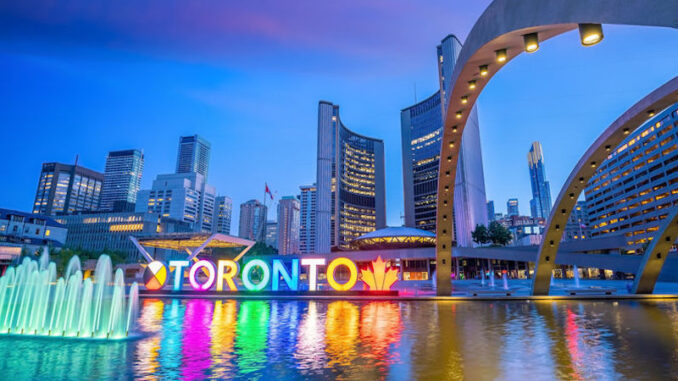
The City of Toronto is moving ahead with the creation of a Cultural Districts Program to maintain and advance Toronto’s identity and international reputation as one of the world’s most multicultural cities.
A Cultural Districts Program in Toronto will allow for more flexibility and opportunity for the City to engage in economic and cultural initiatives to help communities thrive, in particular Church-Wellesley, Little Jamaica, Downtown Chinatown and Geary Avenue, and at least one community and neighbourhood in the former cities of Etobicoke, North York or Scarborough.
To lead the new Cultural Districts Program proposal and the Little Jamaica master planning process, the City is working with Jay Pitter Placemaking. Pitter will engage a diverse range of Torontonians to co-develop a Cultural District Program proposal that outlines the parameters, policy approaches and equitable placemaking and place-keeping principles to guide future cultural districts, which will be sent to City Council for approval. Furthermore, Pitter will collaborate closely with a number of City divisions to co-create an equitable and expansive framework for the Little Jamaica Master Plan, which will honour the Indigeneity of the planning area; centre the contributions of the Jamaican community, while embracing a Pan Africanism lens that will recognize Black placemaking contributions more broadly; and create space for all Little Jamaica residents, businesses and organizations to participate in the process.
An award-winning placemaker whose practice mitigates growing divides in cities across North America, Pitter spearheads institutional city-building projects specializing in public space design and policy, forgotten densities, mobility equity, gender-responsive design, transformative public engagement and healing fraught sites. Her multidisciplinary approach, at the nexus of urban design and social equity, translates community insights and aspirations into the built environment.
While she leads a diverse portfolio of work, her contributions to Black placemaking in both Canada and the U.S. are substantive, including her work on transforming Confederate monument sites in the southern U.S., multiple collaborations in Detroit and teaching an urban policy course titled “Engaging Black People and Power”, spurred by the murder of George Floyd.
Pitter is an urban planning lecturer who has presented at MIT, Harvard, Cornell and Princeton universities, among many others. She was recently the John Bousfield Distinguished Visitor in Planning at the University of Toronto and shortlisted for the Margolese National Design for Living Prize. Her two forthcoming books will be published by McClelland & Stewart, and Penguin Random House Canada. She is currently the Planner-in-Residence at the University of Waterloo, a Visiting Fellow at University of Windsor’s Law Centre for Cities and a Senior Fellow with the Canadian Urban Institute.
More information about Jay Pitter Placemaking is available at www.jaypitter.com/.
Cultural districts are municipally significant areas that have a historical legacy of clustering cultural resources, businesses, not-for-profits and residents which, when combined, uplift the cultural identity and cultural heritage of the neighbourhood. Broader community engagement will occur to inform final recommendations for the program design and implementation in a 2022 City staff report.
More information on the City’s Cultural Districts Program is available at
https://www.toronto.ca/city-go
Additional information about Little Jamaica is available at www.toronto.ca/littlejamaica.
Quotes:
“Cultural districts are a proven strategic approach to protect and promote a stronger sense of belonging for diverse communities through a combination of tools to support businesses, cultural and heritage spaces within delineated areas that are meaningful community hubs. I’m glad to see that the City of Toronto is working with Jay Pitter to move ahead with the creation of a Cultural Districts Program to maintain and advance Toronto’s identity and international reputation as one of the world’s most multicultural cities.”
– Mayor John Tory
“Businesses in the Little Jamaica community have been especially challenged by the combined pressures of the pandemic and the Metrolinx Eglinton Crosstown construction. I’m pleased that the City has retained Jay Pitter to apply her years of expertise in placemaking to support the stabilization, reopening, recovery and rebuild efforts of the area’s Black-owned and operated businesses.”
– Deputy Mayor Michael Thompson (Scarborough Centre), Chair of the Economic and Community Development Committee
“We’re looking forward to working with Jay Pitter to develop a plan for Little Jamaica to help sustain the local Jamaican-Caribbean community through more affordable housing options; and to guide future growth and transit development to support the cultural district and commercial retail businesses on main streets, while using an equity lens that protects its Jamaican-Caribbean identity.
– Deputy Ana Bailão (Davenport), Chair of the Planning and Housing Committee
“My grandmother, a gifted seamstress and baker, made considerable sacrifices to immigrate to Canada from Jamaica so this project is profoundly personal for me. Her indomitable spirit and community service will guide me as I lead the Little Jamaica Master Plan development process in close collaboration with City of Toronto staff, members of my cultural and racial communities and everyone who shares my passion for this iconic place.”
– Jay Pitter, MES, Jay Pitter Placemaking
Source City of Toronto

Leave a Reply